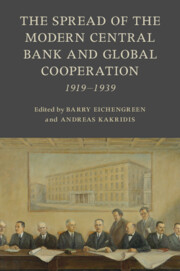Book contents
- The Spread of the Modern Central Bank and Global Cooperation
- Studies in Macroeconomic History
- The Spread of the Modern Central Bank and Global Cooperation
- Copyright page
- Contents
- Figures
- Tables
- Editors and Contributors
- Preface
- Part I General
- Part II Specific
- 5 Central Bank Policy under Foreign Control
- 6 Sneaking Nationalization
- 7 The Bank of Poland and Monetary Policy during the Interwar Period
- 8 From Banking Office to National Bank
- 9 ‘Nobody’s Child’
- 10 The Bulgarian National Bank, 1926–1935
- 11 Macroeconomic Policies and the New Central Bank in Turkey, 1929–1939
- 12 Latin American Experiments in Central Banking at the Onset of the Great Depression
- 13 Central Banks in the British Dominions in the Interwar Period
- 14 Central Banking and Colonial Control
- Index
- References
12 - Latin American Experiments in Central Banking at the Onset of the Great Depression
from Part II - Specific
Published online by Cambridge University Press: 02 November 2023
- The Spread of the Modern Central Bank and Global Cooperation
- Studies in Macroeconomic History
- The Spread of the Modern Central Bank and Global Cooperation
- Copyright page
- Contents
- Figures
- Tables
- Editors and Contributors
- Preface
- Part I General
- Part II Specific
- 5 Central Bank Policy under Foreign Control
- 6 Sneaking Nationalization
- 7 The Bank of Poland and Monetary Policy during the Interwar Period
- 8 From Banking Office to National Bank
- 9 ‘Nobody’s Child’
- 10 The Bulgarian National Bank, 1926–1935
- 11 Macroeconomic Policies and the New Central Bank in Turkey, 1929–1939
- 12 Latin American Experiments in Central Banking at the Onset of the Great Depression
- 13 Central Banks in the British Dominions in the Interwar Period
- 14 Central Banking and Colonial Control
- Index
- References
Summary
To date, research on Latin American central banks in the interwar years has focused on their loss of autonomy due to the slump and subsequent implementation of innovative, countercyclical monetary policies. These policies, although fostering economic recovery, led to higher rates of inflation and exchange-rate volatility. The chapter shows that these policies resulted from more than loss of autonomy and subordination of central banks to governments. In fact, the need for countercyclical monetary policies had been foreseen by foreign advisors to newly established central bank before and during the crisis, but Latin American central bankers had been reluctant to implement them for fear of damaging the credibility of the gold-standard regime. This finally changed with the collapse of the gold exchange standard. In the 1930s, central banks had become effective actors, channeling credit to the real economy and supporting the emergence of state institutions that would promote the development of local industry.
- Type
- Chapter
- Information
- The Spread of the Modern Central Bank and Global Cooperation1919–1939, pp. 320 - 351Publisher: Cambridge University PressPrint publication year: 2023
References
Primary Sources
Secondary Sources
- 1
- Cited by



